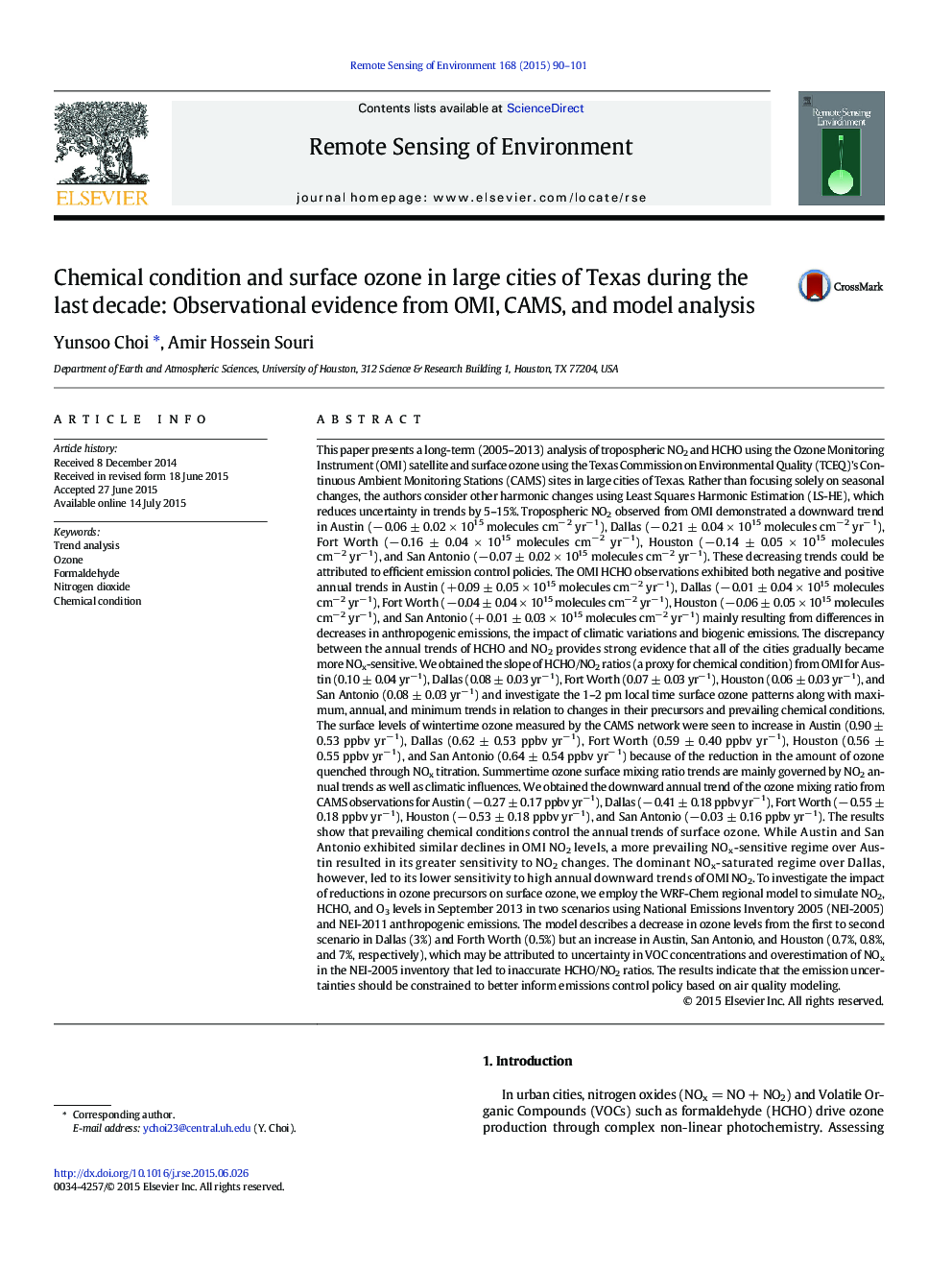| کد مقاله | کد نشریه | سال انتشار | مقاله انگلیسی | نسخه تمام متن |
|---|---|---|---|---|
| 4458808 | 1621232 | 2015 | 12 صفحه PDF | دانلود رایگان |

• A long-term analysis of tropospheric NO2 and HCHO using the OMI satellite
• Analysis of ozone and its precursors using remote sensing data
• Annual NO2 downward trend in Austin, Dallas, Fort Worth, Houston and San Antonio
• Annual HCHO negative or positive trend in the five urban cities of Texas
• A positive slope of HCHO/NO2 ratios (chemical condition) in urban cities of Texas
This paper presents a long-term (2005–2013) analysis of tropospheric NO2 and HCHO using the Ozone Monitoring Instrument (OMI) satellite and surface ozone using the Texas Commission on Environmental Quality (TCEQ)'s Continuous Ambient Monitoring Stations (CAMS) sites in large cities of Texas. Rather than focusing solely on seasonal changes, the authors consider other harmonic changes using Least Squares Harmonic Estimation (LS-HE), which reduces uncertainty in trends by 5–15%. Tropospheric NO2 observed from OMI demonstrated a downward trend in Austin (− 0.06 ± 0.02 × 1015 molecules cm− 2 yr− 1), Dallas (− 0.21 ± 0.04 × 1015 molecules cm− 2 yr− 1), Fort Worth (− 0.16 ± 0.04 × 1015 molecules cm− 2 yr− 1), Houston (− 0.14 ± 0.05 × 1015 molecules cm− 2 yr− 1), and San Antonio (− 0.07 ± 0.02 × 1015 molecules cm− 2 yr− 1). These decreasing trends could be attributed to efficient emission control policies. The OMI HCHO observations exhibited both negative and positive annual trends in Austin (+ 0.09 ± 0.05 × 1015 molecules cm− 2 yr− 1), Dallas (− 0.01 ± 0.04 × 1015 molecules cm− 2 yr− 1), Fort Worth (− 0.04 ± 0.04 × 1015 molecules cm− 2 yr− 1), Houston (− 0.06 ± 0.05 × 1015 molecules cm− 2 yr− 1), and San Antonio (+ 0.01 ± 0.03 × 1015 molecules cm− 2 yr− 1) mainly resulting from differences in decreases in anthropogenic emissions, the impact of climatic variations and biogenic emissions. The discrepancy between the annual trends of HCHO and NO2 provides strong evidence that all of the cities gradually became more NOx-sensitive. We obtained the slope of HCHO/NO2 ratios (a proxy for chemical condition) from OMI for Austin (0.10 ± 0.04 yr− 1), Dallas (0.08 ± 0.03 yr− 1), Fort Worth (0.07 ± 0.03 yr− 1), Houston (0.06 ± 0.03 yr− 1), and San Antonio (0.08 ± 0.03 yr− 1) and investigate the 1–2 pm local time surface ozone patterns along with maximum, annual, and minimum trends in relation to changes in their precursors and prevailing chemical conditions. The surface levels of wintertime ozone measured by the CAMS network were seen to increase in Austin (0.90 ± 0.53 ppbv yr− 1), Dallas (0.62 ± 0.53 ppbv yr− 1), Fort Worth (0.59 ± 0.40 ppbv yr− 1), Houston (0.56 ± 0.55 ppbv yr− 1), and San Antonio (0.64 ± 0.54 ppbv yr− 1) because of the reduction in the amount of ozone quenched through NOx titration. Summertime ozone surface mixing ratio trends are mainly governed by NO2 annual trends as well as climatic influences. We obtained the downward annual trend of the ozone mixing ratio from CAMS observations for Austin (− 0.27 ± 0.17 ppbv yr− 1), Dallas (− 0.41 ± 0.18 ppbv yr− 1), Fort Worth (− 0.55 ± 0.18 ppbv yr− 1), Houston (− 0.53 ± 0.18 ppbv yr− 1), and San Antonio (− 0.03 ± 0.16 ppbv yr− 1). The results show that prevailing chemical conditions control the annual trends of surface ozone. While Austin and San Antonio exhibited similar declines in OMI NO2 levels, a more prevailing NOx-sensitive regime over Austin resulted in its greater sensitivity to NO2 changes. The dominant NOx-saturated regime over Dallas, however, led to its lower sensitivity to high annual downward trends of OMI NO2. To investigate the impact of reductions in ozone precursors on surface ozone, we employ the WRF-Chem regional model to simulate NO2, HCHO, and O3 levels in September 2013 in two scenarios using National Emissions Inventory 2005 (NEI-2005) and NEI-2011 anthropogenic emissions. The model describes a decrease in ozone levels from the first to second scenario in Dallas (3%) and Forth Worth (0.5%) but an increase in Austin, San Antonio, and Houston (0.7%, 0.8%, and 7%, respectively), which may be attributed to uncertainty in VOC concentrations and overestimation of NOx in the NEI-2005 inventory that led to inaccurate HCHO/NO2 ratios. The results indicate that the emission uncertainties should be constrained to better inform emissions control policy based on air quality modeling.
Journal: Remote Sensing of Environment - Volume 168, October 2015, Pages 90–101